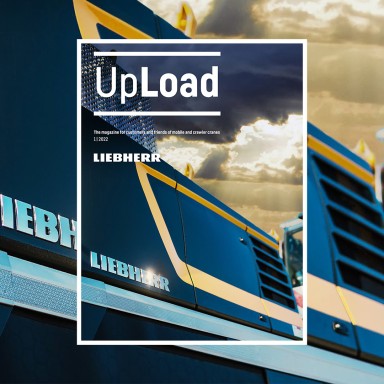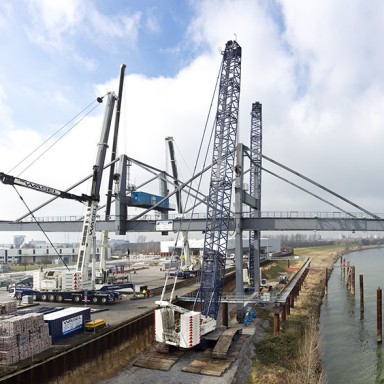
9 minutes | magazine 01/2022
Déjà-vu at Ammersee
Wind, wind, wind. Everybody involved with cranes or jobs with them knows very well that wind is a massive topic when we want a crane to work.
Installing a cover on a massive parabolic antenna using Liebherr mobile cranes
If the wind speeds are excessive, sensitive crane assembly work may be delayed for weeks rendering detailed plans absolutely useless. Waiting for days to assemble wind turbines, for example, is hardly a rarity. To stay with this example, crane work at wind farms must be stopped if the wind reaches a speed of more than six to nine meters per second depending on the hoist height and type of load. Here at Liebherr, we calculate these limits for tricky hoisting work for our partners precisely. Last autumn an assembly job took place in southern Germany, which was extremely susceptible to wind and for which the limit was actually reduced to just two meters per second.
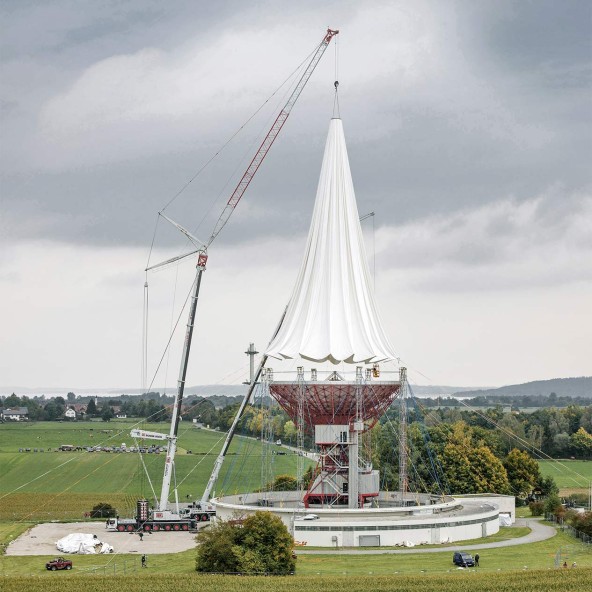
2010
To recap briefly, a deep storm low with the pretty name of “Bianca” passed over large parts of southern Germany in February 2020. In some places, weather stations recorded wind speeds of over 160 kilometers per hour. The region to the south of Lake Ammer in Bavaria did not escape the ravages of the storm. Since 1963, the spherical protective cover on “Antenna 1” at Raisting Earth Station has projected up into the sky like a giant puffball, visible for miles around. This industrial monument is known by the name “Radome”, an abbreviation of the words “radar” and “dome”. Its white air dome, a threequarter sphere with a surface area of 5,300 square meters, held in shape permanently by a fan generating a low pressure in it, fell victim to the winter storm. Since then the luminous red directional antenna has been exposed to the elements. Recording the damage, issuing a tender, planning and production of a new spherical membrane – all this takes time.
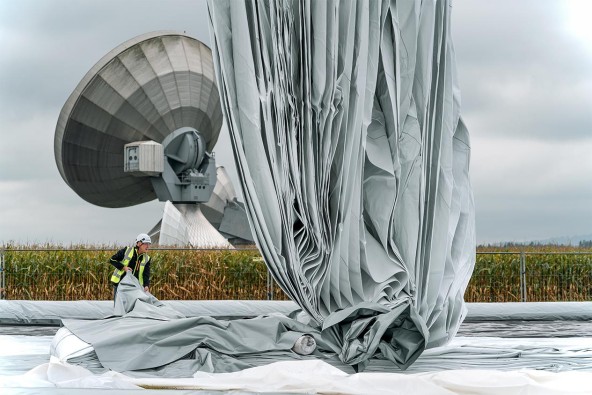
Origami? Not really. But certainly the art of folding. The giant cover with a total surface area of 5,300 square meters is spread out. The process would have been impossible without the help of the mobile crane. More parabolic antennas at the Raisting Ground Station can be seen in the background.
More powerful crane – greater stability
“We have been planning this job for well over a year”, says Johann Würz. Würz headed up this challenging job in the Bavarian foothills of the Alps on behalf of crane contractor BKL Baukran Logistik GmbH. Just eleven years ago, a Liebherr LTM 1400-7.1 mobile crane from the same contractor was used to replace the membrane, which at the time was almost 50 years old and had become porous. On this occasion, Würz initially wanted to use an LTM 1500-8.1 crane. “Then the plan was changed and a decision was made that the cover should be stretched out at its seams and snap-fitted over the radome. Naturally, that gave the wind a larger area to attack. That is why we decided instead to take our new LTM 1650-8.1”, the most powerful mobile crane in the company’s large fleet. “It was important to include an adequate safety factor and have plenty in reserve. It also means that we were ideally prepared for any surprises,” continues the experienced professional.
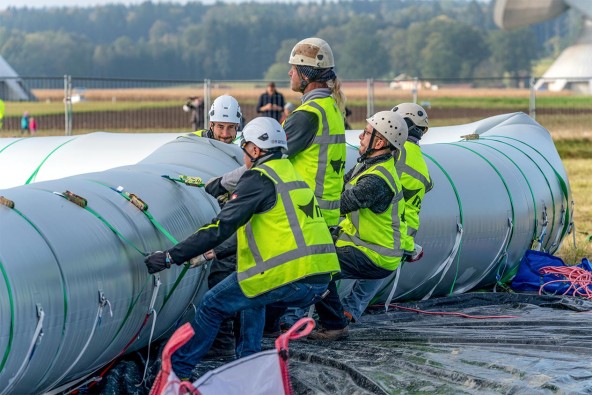
Thick tube: Massive hoses filled with air pressure are used. They also protect the technical system and the membrane when snap-fitting it over the directional antenna.
Johann Würz also sent an LTM 1230- 5.1 to Raisting as a second crane for working with a personnel cage and for setting up the larger crane. This modern five-axle model arrived at the site a few days earlier. It helped to hoist the membrane, which had been manufactured in Turkey, off the truck, unpack it and unfold it on a prepared surface. The new cover weighed a good ten tonnes and without the powerful boom on the mobile crane, it would not have been possible to move it. Before the new cover could be hoisted into position, an air hose, a tube with a diameter of one meter had to be installed along its opening. The idea behind this was that when it was hoisted over the parabolic antenna, it would be possible to push the opening on the underside apart. Additional hoses filled with air pressure were installed all around the antenna by rope access technicians and the crane. To protect both the fabric cover and the technical systems on the industrial monument.
Key data on the lift:
5,300 square meters
2 m/s max. wind speed
10 tonnes
During the process to unfold the plastic, gentle gusts of wind could be felt, with the massive surface area of the membrane susceptible even to a light breeze. The fitters on the ground had their hands full in keeping the cover under control whilst it was suspended from the crane’s hook. It quickly became plain that installing the cover on the antenna would be virtually impossible in anything beyond a slight breath of wind in the air.
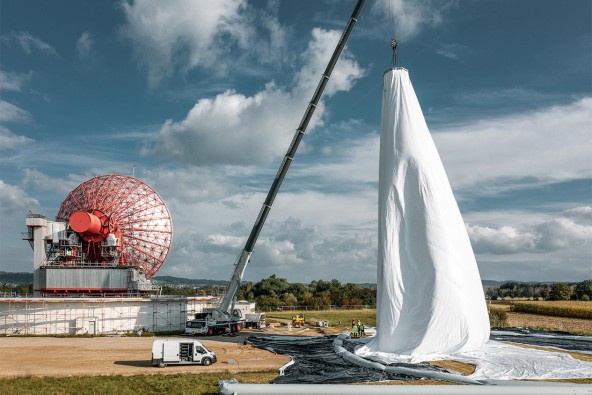
A light breeze: Even during the preparations, a little wind made the cover difficult to handle. The 5,300 square meter plastic cover acted like an enormous sail.
Veto by crane driver
It was in fact the gusty weather that then blew the site schedule completely out of the window. On the day scheduled for the installation work, the anemometer on the luffing jib of the LTM 1650-8.1 showed in the crane operator's cab that the wind speeds were permanently too high. Everything and everyone was ready when, as the breeze increased, the crane operator finally issued his considered but determined decision to call a halt to work for the day after discussing the situation with everybody concerned. They decided to try again the next morning. The meteorologists had forecast the prospect of a brief period of no wind. They decided to start work well before sunrise.
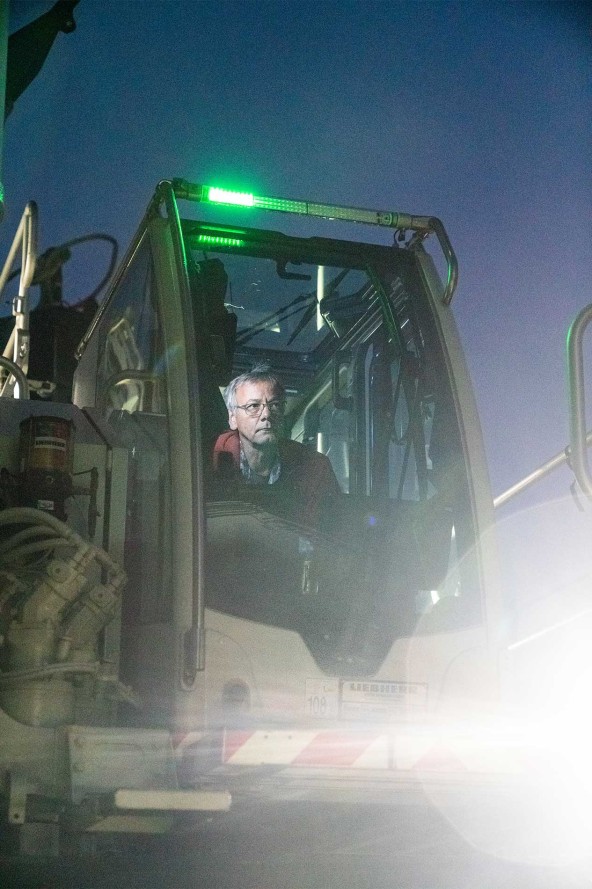
All in the green sector: BKL crane operator Steffen looks relaxed as he views the night-time scenery. The weather forecast and anemometer on the crane jib report almost zero wind. Perfect conditions for hoisting the new radome cover.
There was a dense fog over the site when the area for suddenly filled with life again shortly after five in the morning. The forecasts from the previous day proved to be accurate – there was not a breath of wind and the job could finally be started. Still before the sun had risen, the “hook up” instruction was heard and the giant white membrane slowly rose out of the fog. When BKL crane operator Steffen had hoisted the load to a hook height of around one hundred meters, the teams on the retaining ropes started to use winches and muscle power to spread the opening of the now skirt-shaped cover more and more. As if in slow motion, the luminous red of the parabolic antenna disappeared behind the gigantic white curtain. The rest went very quickly. By the evening, the cover had been connected to the round plinth on the system to make it airtight and the giant ball was filled with a low pressure. After eighteen months, the radome finally had its protective cover back in place.
In Raisting, or more accurately, at Radom Raisting GmbH, a company fully owned by the Rural District of Weilheim-Schongau, they now hope that the radome is well protected for the future. “We had the hybrid cover, which is made up of around one hundred individual parts, made in such a way that the diagonal strips of fabric are aligned to the direction of the forces on it so that they can withstand them whilst having more in reserve,” says René Jakob, the longstanding Managing Director of Radom Raisting GmbH. “And we are delighted that in the end, everything went so well.”
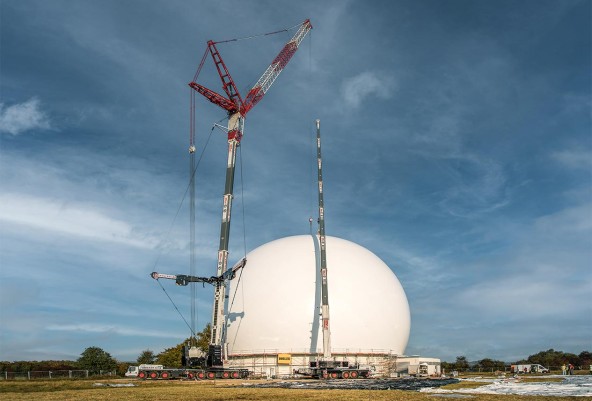
From moon landing to “Cold War”
Until it was decommissioned in 1985, the satellite ground station played an important role in radio and telecommunications systems on a global level. The most important use of the radome was certainly the transmission of the first moon landing by the Apollo 11 mission in June 1969. The television signal was transmitted from the NASA Centre in Houston, Texas by satellite to the parabolic antenna in Raisting, from where it was broadcast to large parts of Europe. The Summer Olympic Games in 1972 held in Munich were also broadcast around the world by the radome. Furthermore, the American forces stationed in West Germany used the ground station to acquire a particularly secure connection to the USA during the Cold War.
This article was published in the UpLoad magazine 01 | 2022.

